Summary
What is a solar eclipse?
Despite the sun being roughly 400 times larger than the moon, it’s also about 400 times further away from Earth. The moon’s orbit of Earth is slightly tilted from the path the sun takes through our sky, but it does intersect. Consequently, a new moon sometimes gets perfectly aligned between Earth and the sun, resulting in a solar eclipse.
What is an annular solar eclipse?
An annular solar eclipse occurs when the moon is at its farthest point from Earth in its orbit, making it appear smaller in the sky. Observers located in a narrow path across Earth’s surface will see a beautiful ring of light surrounding the dark disk of the moon. However, it is essential to wear solar eclipse glasses at all times to protect your eyes.
When is the next eclipse in North America?
The next solar eclipse is set to occur on October 14, 2023. This event will be an annular solar eclipse—often called a “Ring of Fire” eclipse—and will be visible across North America. Unlike the previous event in 2021, this eclipse will last over four minutes and can be viewed across the western U.S. from Oregon to Texas, as well as in several other countries including Mexico, Belize, and Colombia. Key attractions that will experience the eclipse include the ancient Mayan temple of Edzná in Mexico and stunning natural sites like Crater Lake National Park in Oregon and Monument Valley in Arizona.
In various U.S. cities, viewers can expect differing levels of eclipse visibility. For instance, Los Angeles will experience a 70-percent coverage of the sun at 9:24 a.m., while Austin, Texas, will be in the path of an exact Ring of Fire. It’s worth noting that Austin will enjoy an 88 percent partial eclipse at around 11:54 a.m. Additionally, just six months afterward, Texas will also witness a total solar eclipse.
Great North American Eclipse of 2024
Mark your calendars for April 8, 2024, as this celestial spectacle promises to be extraordinary. The “Great North American Eclipse” will not only cover the United States but also cross through parts of Canada and Mexico, creating a memorable experience for sky gazers.
The totality, or the path of the moon’s shadow across Earth’s surface, is crucial for experiencing a complete solar eclipse. At lunchtime, totality will travel over cities like Mazatlán and Durango in Mexico, before moving through Texas, Oklahoma, and continuing through to Maine in Canada.
Both Austin and Dallas will enjoy over four minutes of totality, significantly more than what was seen during the 2017 eclipse. However, for those outside the 100-mile-wide path of totality, only a partial eclipse will be visible. Therefore, it’s essential to plan accordingly to ensure the best possible viewing experience.
If you miss the 2024 eclipse, the next opportunity for a total solar eclipse in North America will not arrive until 2026. However, adventurous travelers can experience total eclipses in Spain, Iceland, Australia, and New Zealand in the years to come.




